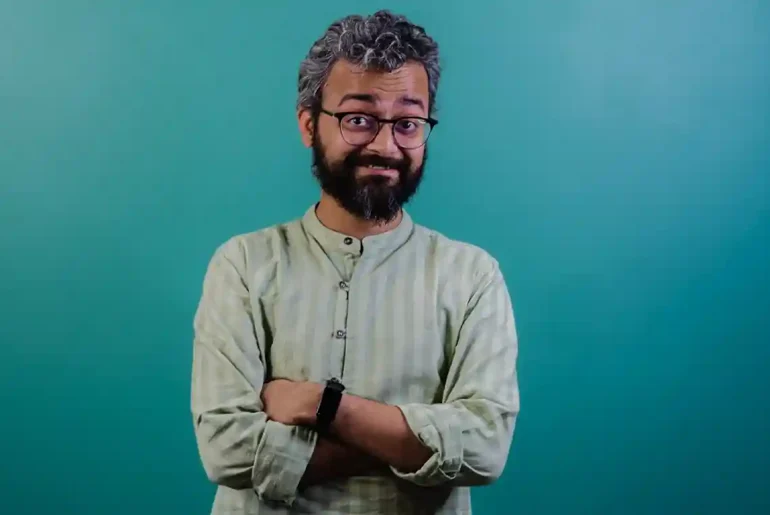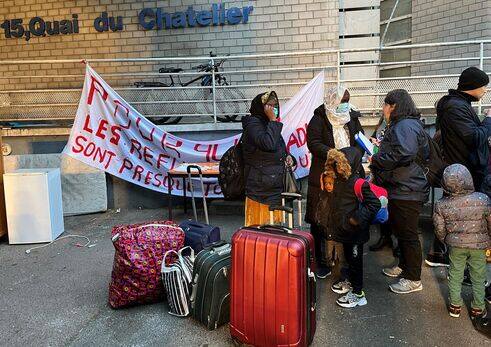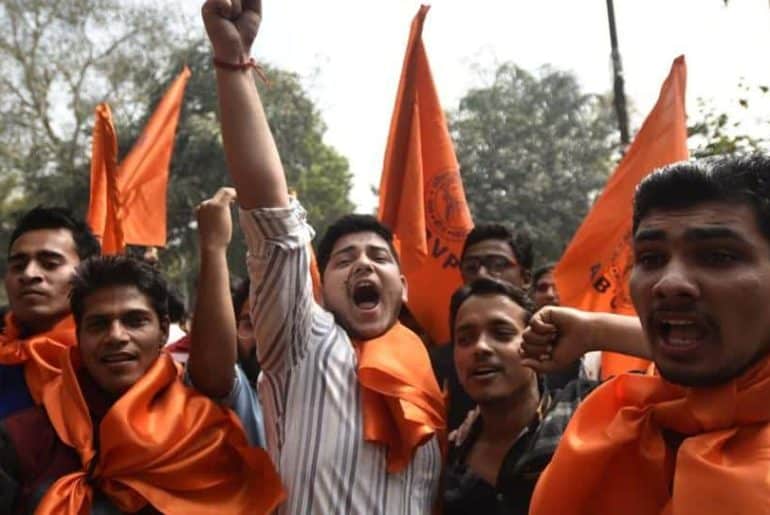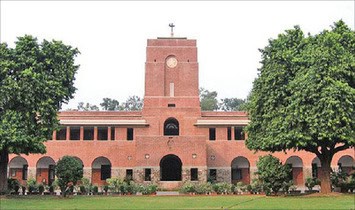“Do I lose it?” Meghnad asked the small crowd that forms his ragtag cadre, pointing to the red net chunni someone had hung around his neck during his rally the day before through Green Park’s residential block. The crowd consisted of some subscribers, students who follow his social media, former colleagues from his journalism days, and his managers who helped him through his candidature filing process. We settled on keeping the chunni; it made him stand out.
The researcher-turned-journalist-turned-Youtuber was affable and approachable, as he handed me his printed manifesto with the slogan Pen Chunno, Kaam Dekho scrawled across it; the pen nib being his symbol, which to everyone’s shock had not been chosen by any candidate or party before. We were handed pamphlets and pens to distribute – instead of liquor bottles and wads of cash, symbolic of the critique of parties like AAP, who, according to the Indian Express, have spent more on welfare/freebies, than infrastructure, or education for that matter, in the past term.
The stab of the manifesto was felt rather clearly as we walked from Green Park to Humayunpur; a microcosm of the capital’s civic shortcomings revealed itself—a space marked by the lack of proper waste management, the constant smell of smoke in the air, hanging wires, and the unregulated construction—issues that the city’s residents have grown hardened to, but still wish were addressed.
Malviya Nagar is a surprisingly small constituency, representing around 1.48 lakh voters, but it is home to a large number of migrants—students from around the country, workers from Bihar and Uttar Pradesh, Afghan refugees, etc. “I like to call it the ground-floor constituency—only the ground floor residents are voters, and they are usually landlords who often deny their tenants residence certificates but the government doesn’t care as long as they have the rentees’ votes,” Meghnad said as we walked past a stretch of barren ground littered with BJP and AAP banners in Humayunpur, which is supposed to be a park. Opposite to it stood a brightly coloured mural on the wall of a small house. It had been painted by a group of migrant workers, whom we met. “Accha toh lagna chahiye, hum rehtey hain yahan,” they said, stopping their game of teen-patti to speak to us.
Meghnad’s manifesto addresses and seeks to remedy the issues that are common to most neighbourhoods in South Delhi—revival of the shabbily maintained public parks for women, children, and the elderly (humara nukkads); strict preservation of safety given the murders in the past five years; composting, and creation of awareness about waste disposal. It is basic civic textbook stuff that seems impossible to implement. However, our YouTuber Neta was banking on his digital presence, approachability and optimism. The latter were undoubtedly infectious.
“This ‘vote-cutting’ narrative hurled against independents is unfair; it’s offensive to the voters—big parties aren’t entitled to their votes. Would they accuse Congress candidates of the same? After all, every candidate is equal in the eyes of the ECI; we go through the same processes, we’re meant to follow the same rules,” said Meghnad as we stood outside a small BJP booth in Humayunpur where he distributed flyers and chatted with Sanghatan members, many of whom lauded his commitment to running independently, some party volunteers even encouraging him to join them.
“I have familial ties to the party [BJP], so I owe my vote to them, but if that wasn’t the case, I would’ve chosen an independent like Meghnad. Unka tareekha accha hai, har dukaan mein jaakar, sabse baat karna,” a BJP party volunteer claimed as we spoke to them outside the BJP vote station in Green Park’s Y Block Market, where they had come to rally support for Satish Upadhyay, the party’s candidate from the constituency. However, there remained a deep lack of faith in just how much support an independent could rally, despite the initial endearment.
Ravindar Kanwar, another BJP party worker from Delhi Cantt. constituency opined the same, “He’s a good guy, but it’s like comparing a paan ki dukaan to a mall; independents just do not have the same resources.” He was right. According to Election Commission guidelines, independent candidates’ spending on campaigning is capped at 40 lakh rupees, but parties are free to spend as they please. As other rally members and I quickly gathered, the sense of camaraderie was not all that deep. Kanwar later added that he was sure the BJP would win, but that shouldn’t discourage him [Meghnad]. They offered him tea, but maybe they didn’t think they were offering it to an opponent.
When I later asked Meghnand what it would be that’d bring about his loss, if it does eventually come, he said, “It’s because social change is difficult, appeasement is easy.” One of his friends chimed in from the back, “It’s shocking that no one considered doing this before, running independently and also making the process transparent and accessible to other citizens. It is unfortunate that no one even considers looking beyond the party structure for representation.”
His friend was referring to Meghnad’s Project Anda, a tongue-in-cheek reference to the possibility of getting zero votes but more so his Wikihow-esque series of videos and live streams on the process of filing a candidature, getting through the paperwork to secure a nomination and then actually running for MLA elections. “The government lacks the language to make this process accessible to people and so does the ECI. That’s what I want to use my platform for. I’ve already had a few people come up to me at rallies who’d like to stand as independents,” Meghnad responds when I ask him why he, a citizen, has to make a guide for other citizens on how to represent themselves.
He further acknowledged how complicated the process of filing is, one which he was able to navigate given his prior experience in the realm of public policy. “I’m a content creator, this election is also for content, but my profession marries in very well public service, which may not be the same for other professions. But, at the end of the day, you really need to just be accessible.”
Meghnad’s civic service journey has also reinstated his faith in EVM. “It seemed quite foolproof to me. I spoke to the engineers, tested out the machines. The ECI may have its flaws when it comes to upholding the moral code of conduct, but in my opinion, EVMs seem difficult to hack.”
Meghnad’s campaign isn’t just an electoral one, it is also one for content that’d make citizens aware of the underbelly of public representation—a crisscross of red tapism, overworked election and public officers, and a testament to India’s love affair with lengthy legalities. It is a plague which blights almost every government process in the country. However, as Meghand makes clear, it is not an untangleable mess. Referencing one of his older interviews with J&K’s current Chief Minister, Omar Abdullah, Mehghnad adds that he is truly a product of the fatigued and disillusioned public, thrust towards civic action to save his home from disarray. Useless politicians may spawn useful citizens.
As Meghnad struggled to not zip past his own rally, it became clear—this man is no politician, but he is not afraid to lead. “If you hand a man a slipper every time he needs one, what will he learn? Politics needs to go beyond hand-outs, our leaders need to criticise their subjects while they admit subjection to the same, not just appease them.” His aspect is ordinary, approachable and humble, a refreshing break from the usual strongman and paternalistic politics that bleeds through this country. Amidst the shrill Sheesh Mahal discourse and general voter malaise of the current election, Meghnad’s rally emanated a hope fleetingly tangible—India needs a politics without politicians.
Featured image: Yashasvi Singh Raghuvanshi




